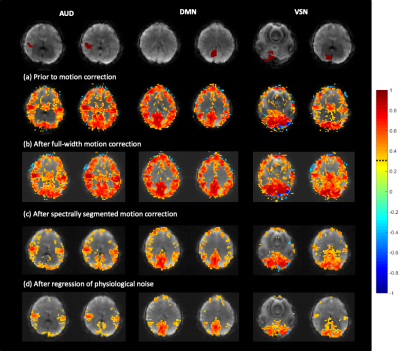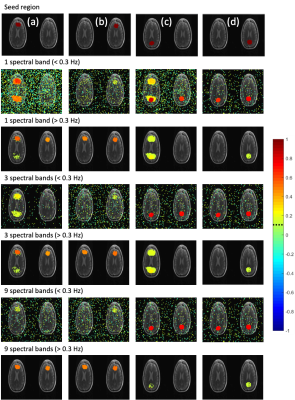Khaled Talaat1, Bruno Sa de La Rocque Guimaraes1, and Stefan Posse2,3
1Nuclear Engineering, U New Mexico, Albuquerque, NM, United States, 2Neurology, U New Mexico, Albuquerque, NM, United States, 3Physics and Astronomy, U New Mexico, Albuquerque, NM, United States
1Nuclear Engineering, U New Mexico, Albuquerque, NM, United States, 2Neurology, U New Mexico, Albuquerque, NM, United States, 3Physics and Astronomy, U New Mexico, Albuquerque, NM, United States
A new
spectral and temporal segmentation approach of nuisance signals is shown to avoid
injection of artifactual connectivity and substantially improves physiological
noise and motion effects throughout the whole frequency spectrum when
uncertainties are present in regression vectors.

Figure 5: Application of the present method
to an in vivo high-speed resting-state fMRI scan and comparison with
full-width, whole band
correction of
motion-related signal changes
with seeds in the auditory network
(AUN), the default mode network (DMN), and the visual network (VSN). Data were
acquired using multi-slab Echo Volumar Imaging with TR: 246 ms, isotropic voxel
size: 4 mm, number of time points: 3000, multi-band factor: 2, in-plane GRAPPA
acceleration: 3. Correlation threshold: 0.3.

Figure 3: Dependence of spectrally
segmented regression of the noised model (simulated resting-state fMRI data
with noise from in-vivo scan motion parameters added) on the number of spectral
bands of the regression vectors. False positive correlations decrease with
increasing spectral segmentation. Color bar shows correlation range between -1
and 1 and correlation threshold: 0.1.
